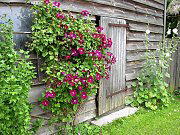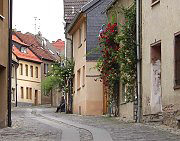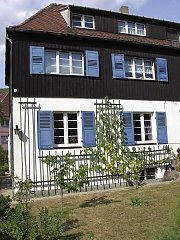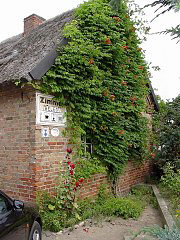Care and Maintenance of Climbing Plants
Naturally, climbing plants require maintenance and trimming! First comes an establishment phase: the plant is guided on its support during initial growth. After the plant reaches the desired coverage area, regular maintenance is then required to sustain the plant and its form. The effort (and time) required for maintenance in each phase differs greatly from plant to plant. Here we'll show you how skillful plant selection and a clear delineation of the area to be greened will minimise the maintenance required.
Plant Selection and Maintenance (see diagram)
*Relative maintenance requirements of different climbing plants (title of diagram)
Life Span in Years: Ivy, Hops, Honeysuckle, Silver Lace Vine, Pipevine, Virginia Creeper, Grapevine
English ivy (Hedera) and other self-clinging climbers, like Boston ivy(Parthenocissus tricuspidata) and Virginia creeper (P. quinquefolia) have the advantage of not needing a support (usually) and are really low maintenance, in the first years anyway. Watering is almost never necessary. After 5-10 years, it is time for the first trim. During the following years of the maintenance phase, when full growth is reached - usually up to the roof connection - considerable pruning work is done every year to keep windows and the roof eaves free... at least in theory. In actuality, this maintenance is often neglected and problems at/on the roof are overlooked, until the roofer discovers them...
Hops and annual tendril climbers: For these plants, it is above all a question of working the soil (watering, fertilising) and on removing dry shoots in autumn. Overall low-maintenance, even after several years. The same is true for clematis hybrids which will last one season and need to be replanted each year.
Honeysuckle and other twining plants, such as akebia or climbing hydrangea often require a lot of initial care and need to be closely monitored early on. The greening project will likely not survive the establishment phase if you skimp on maintenance here. The young shoots of well-rooted plants develop very quickly, which is perfect for forming the plant but which also makes for fairly constant maintenance. But metre-thick mats of accumulated dead shoots can result if the plant is left to its own devices (that is, unpruned). Watering is needed, or at least helpful, and some heftier thinning or regenerationpruning is required every 3-5 years.
Silver Lace Vine (or Russian Vine, Polygonum aubertii): Initial maintenance is minimal to none, but as soon as the establishment phase is over, extensive pruning is in order to tame the explosive growth of the plant. Watering is not (or very seldom) necessary. Bittersweet behaves similarly, but will need more water.
Dutchman's pipe (Aristolochia macrophylla and A. tomentosa): These species require a lot of initial care in order to grow, but after that - apart from their relatively high water needs - they are almost maintenance-free, as they develop rather sparse shoot growth requiring little trimming. The biomass consists mostly of large leaves, which drop off in autumn.
The thicket creeper (or woodbine, Parthenocissus inserta) and other similar twining plants like.Clematis montana are relatively low-maintenance through all phases, need little to no water, and are therefore a favourite for greening projects. Thinning and rejuvenation pruning is required from time to time.
Grapevine (Vitis vinifera), espaliered fruit trees, climbing roses (rosa), trumpet vines(campsis), and wisteria can usually only flourish against a facade when they are trained strictly into shape, this shape maintained through regular pruning. This high maintenance factor will remain throughout the lifespan of these plants. Except for the wisteria, their water needs are also rather high. With grapevines, roses, and espaliered trees: an additional and very important aspect of plant care is plant protection (spraying and/or appropriate selection of mold-resistant varieties).
Size of Your Greening Area
Clearly, a larger greening area will require more maintenance, e.g. watering and pruning more often. Costs rise in proportion with the surface area and, due to issues of accessibility, escalate with the increasing height of a wall.
Up to 2m high: small trellises, a single plant, and detail / low greenings up to 2m high can be reached without a ladder and managed by one person.
Up to 5m high: Up to this height, greenery can still be reached with a single leaning/telescopic ladder, but the ladder should always be secured by a second person (doubling the manpower required -- labor costs if hiring).
Over 5m high: High façade greenings can often only be reached via a cherry-picker (a hydraulic lift), which is extremely expensive. In an urban or public street space, it will usually be necessary to apply for a temporary occupation of the public road, which must be indicated by regulatory signage; during the work, the area and passers-by have to be secured from falling materials. The cherry-picker has to be transported, set up, then disassembled and returned. A single operation of this kind with a vehicle and 3 workers can easily cost over 1,000€ -- likely many times the original set-up costs for the greening!










